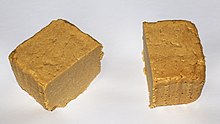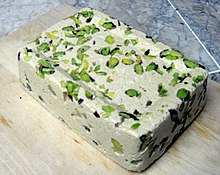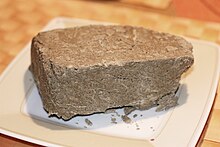Halva
Halva or Halwa (h) is a confectionery specialty that originally comes from India , Iran , Pakistan and Central Asia . Halva is also known in the Middle East , Southeast , Central and Eastern Europe .
etymology
In Arabic the dessert is called Halawa /حلاوة / ḥalāwa denotes which extends from the rootحلو / 'Sweet' derives; in Israel it is very popular under the name חלווה chalwa and in Poland under the name chałwa . In Turkey it is called helva and in Greece Χαλβάς chalwas; in Serbia it is offered under the name alva or halva , in Macedonia as alva and in the rest of former Yugoslavia as halva . In Bulgarian and Russian it is known as chalwa ( Bulgarian and Russian Халва ; emphasis on the final vowel). Turkish honey does not refer to halwa, but to Montélimar nougat .
ingredients
Although the ingredients vary from region to region, the basic mixture generally consists of a sauce made from oil seeds and honey , sugar or glucose syrup .
Halva is refined or flavored by adding vanilla or ethyl vanillin , cocoa , nuts , almonds or pistachios .
Manufacturing
Halva is produced in three production steps. First, peeled sesame seeds are ground to a pulp. Then sucrose and glucose syrup are boiled as a solution at 130 to 140 ℃. It is soap root extract as added protein, beaten to a frothy mass and further reduced under heat or other whipping agent. Finally, the sesame seed pulp is worked in. The following raw material proportions are given for Halwa (Halawa Tahina): sucrose 15–50%, glucose syrup 25–50%, protein solution (soap root extract) 5–15% and sesame pulp 15–20%. The high proportion of oil in sesame seeds can cause oil to escape from the mass.
The use of soapwort as an additive is controversial . Until 2008, the addition of soapwort as a whipping agent was not permitted in the EU . However, the clogging was found and criticized in numerous investigations. After Turkey intervened, on April 11, 2008 the EU Standing Committee on the Food Chain and Animal Health did not classify soapwort extract as a food additive , but as a "characteristic ingredient" in halva and therefore as permissible.
Country-specific variations and peculiarities
Iran and Turkey is tahini-Helva consisting of sesame paste ( tahini is made), spread most often. In the Turkish cuisine and in the Persian cuisine, Helva is also made in two other variations (semolina helva and flour helva).
In Russian and Romanian cuisine , chalwa ( Russian Халва , Romanian halva) is usually made from sunflower seed pulp .
In Greek cuisine , halvas ( modern Greek Χαλβάς ) is also made from durum wheat semolina.
In Indian cuisine , halva refers to a confectionery in the form of a thickly stirred paste or a casserole such as carrot halva , chickpea halva or ginger halva .
A confectionery specialty related to the halva is the Spanish turrón .
See also
Individual evidence
- ^ Gil Marks, The World of Jewish Cooking. (Simon & Schuster: 1996) p. 210.
- ↑ Hartmut Hoffmann: Sugar Goods, in: Hartmut Hoffmann, Werner Mauch, Werner Untze: Sugar and Sugar Goods, Hamburg: Behr's Verlag, 2000 ISBN 3-86022-937-0 , pp. 81–192.
- ↑ Gabriele Krämer: Labeling defects and general composition , confectionery - test results 2007, Bavarian State Office for Health and Food Safety, March 10, 2008, updated on February 9, 2012, accessed on March 16, 2019.
- ↑ Annual report of the food control in Baden-Württemberg for the year 2005 - general report , p. 49 (PDF, 4.9 MB), accessed on March 16, 2019.
- ↑ Annual report of the food control in Baden-Württemberg for the year 2009 - general report , p. 63 (PDF, 6.9 MB), accessed on March 16, 2019.



